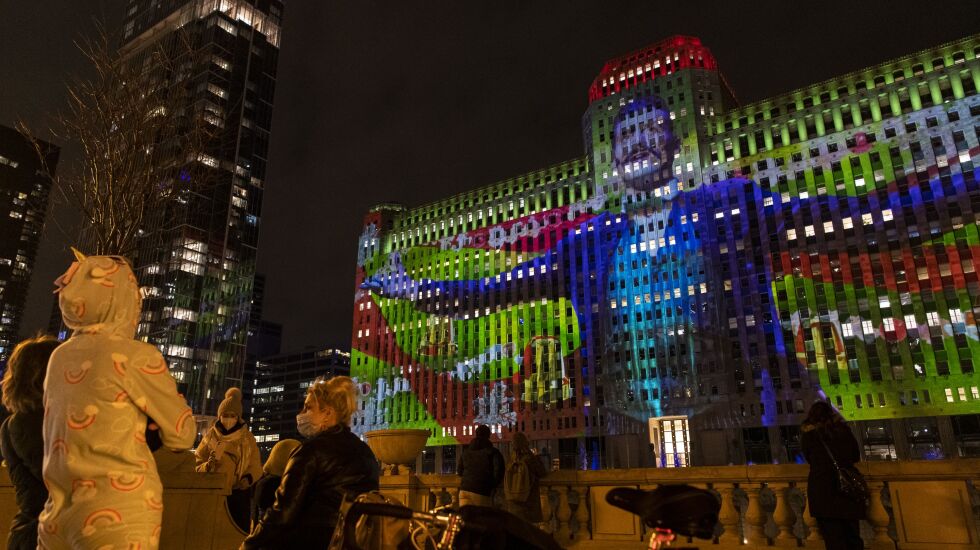
About a decade ago, Chicago’s Merchandise Mart became hip. It was great for the Art Deco-style property that’s one of the most familiar buildings among the city’s architectural royalty, but it wasn’t enough.
There was still a matter of space that wasn’t used well and a design that could seem off-putting to casual visitors and some tenants. The building’s owner, Vornado Realty Trust, first worked to fix that in 2016 by investing $40 million toward changes that included a broad staircase that connects to the lobby.
Now, Vornado and its design partner Gensler are nearly finished with another $40 million job, renovations intended to keep the place relevant in a post-pandemic cycle of companies shrinking their space and staff toiling from home.
The plan is to make this office edifice fun, almost like the student activities center some will recall from their college days, said Glen Weiss, executive vice president at Vornado.
“People want to be active during their daily lives in the office,” he said.
He added that they want to get away from their desks for coffee, a workout, meeting someone for drinks after work or maybe logging onto their laptops from a comfortable seat — outdoors in the good weather.
There will be a lot of exercising, socializing and imbibing going on if the plan is a hit.
The building’s second floor has new retailers specializing in beauty and wellness and a 23,000-square-foot health club, offering classes and a juice bar. For more relaxed pursuits, there’s a tenants-only speakeasy-themed lounge overlooking the river.
The building’s southern exposure benefits from the attention. The South Lobby has a hotel-like treatment with more comfortable seating. The vehicle access drive between the Mart and the river has had traffic lanes constricted to create a River Park pedestrian plaza with al fresco dining and a lawn for community gatherings.

“We have the largest river frontage in the city and for a long time we parked cars on it. This will make better use of that space,” said Paul Heinen, chief operating officer at the Mart.
It’s as if the building now has a front yard, a new way for people to connect with the 93-year-old landmark, like the nighttime “Art on The Mart” projections of digital images on the façade that Vornado coordinates with the city.
Tenants also get a 21,000-square-foot conference center with lounge areas and a café. Heinen said the shared conference space appeals to users who have trimmed their office space and don’t need constant access to meeting rooms.

Vornado has branded the building as the Mart but that’s unlikely to dislodge its traditional name in the heads of most Chicagoans. It’s always appealed to people’s taste for superlatives. When it was under construction in the 1920s, it was touted as “the largest building in the world.” But that was before the Pentagon and other structures. Today, its description is still impressive as the “largest privately held commercial building in the United States.”
The Kennedy family, of political fame, owned it for more than 50 years. Vornado bought it from the family in 1998.

The company’s improvements are to debut officially for this year’s NeoCon show for the commercial design industry June 12-14, a big annual event on the building’s calendar.
Along with special events, office leasing and wholesale showrooms make up the core of the Mart’s business. The mix has changed over the years. The showrooms used to dominate and were generally inaccessible to the public. While that business has declined, Heinen said the segment still accounts for about a third of the Mart’s 3.7 million rentable square feet.
The office part got a boost in 2012 when the tech incubator 1871 made the Mart its home. Around the same time, Motorola Mobility, then owned by Google, signed a lease for about 600,000 square feet. Today, it’s still the largest tenant. Others include Allstate, Medline Industries, PayPal and Grainger.
Weiss said corporate users are drawn to the building’s historic character and to its vast layout that allow many workers on a single floor. In that way, the Mart became a River North alternative to the Old Post Office renovation in downtown’s southwest quadrant. “CEOs are still seeking places like this. It’s not just glass-sealed offices for everyone,” Weiss said.
In its most recent quarterly filing, Vornado said the Mart was 81.6% occupied, putting it on par with a weak downtown market. Vornado is under pressure, especially from its New York holdings, because of falling rent receipts and higher interest rates. It suspended its dividend, a tough choice for a real estate investment trust with stockholders who like income.
But at the Mart, Weiss said, Vornado has made investments to ride out economic cycles.
“If you have the right real estate, you are leasing space. [The Mart] is a forever asset,” he said.









